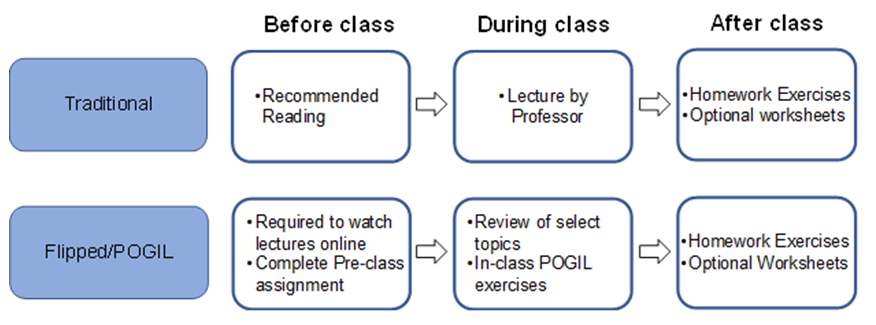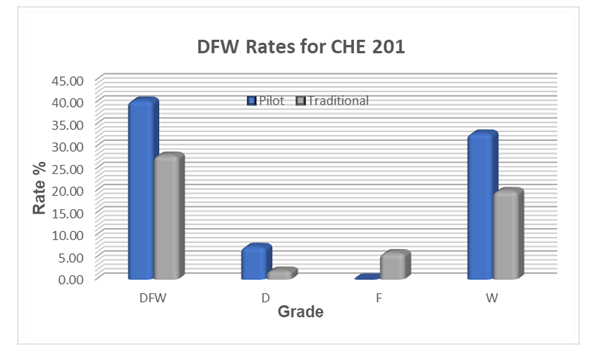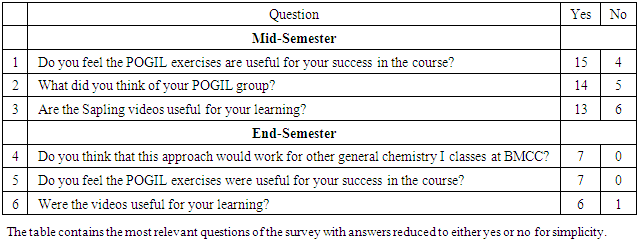-
Paper Information
- Paper Submission
-
Journal Information
- About This Journal
- Editorial Board
- Current Issue
- Archive
- Author Guidelines
- Contact Us
Education
p-ISSN: 2162-9463 e-ISSN: 2162-8467
2020; 10(1): 19-23
doi:10.5923/j.edu.20201001.03

Combining Flipped Classroom with POGIL in an Urban Community College Setting: A Pilot Study
Nipa Deora, Nathalie Rivera, Sheila Sarkar, Marcos Betancourt, Lauren Wickstrom
Department of Science, CUNY, Borough of Manhattan Community College, New York, NY, USA
Correspondence to: Nipa Deora, Department of Science, CUNY, Borough of Manhattan Community College, New York, NY, USA.
| Email: |  |
Copyright © 2020 The Author(s). Published by Scientific & Academic Publishing.
This work is licensed under the Creative Commons Attribution International License (CC BY).
http://creativecommons.org/licenses/by/4.0/

In recent years, there has been an extensive effort to adopt more student-centered teaching methods in higher education. To this end, the flipped classroom approach has become considerably popular. While this method has proven very useful and has shown promising results in multiple settings, it still comes with its challenges. The required work outside of the classroom in an active learning format is significantly greater than in a more passive lecture environment found in the traditional classroom. In this paper, we analyze the successes and challenges encountered as we administered the flipped classroom along with POGIL (Process Oriented Guided Inquiry Learning) methods in our General Chemistry I course at the Borough of Manhattan Community College (BMCC), an urban community college under the City University of New York (CUNY). Our results revealed a mixed attitude towards this set up and our grades were comparable to the grades obtained from the traditional classroom set up. We did not see an improvement in overall grades as hoped, however, there was an increase in passing grades, which we attribute to this format.
Keywords: Flipped Chemistry, Community College, POGIL
Cite this paper: Nipa Deora, Nathalie Rivera, Sheila Sarkar, Marcos Betancourt, Lauren Wickstrom, Combining Flipped Classroom with POGIL in an Urban Community College Setting: A Pilot Study, Education, Vol. 10 No. 1, 2020, pp. 19-23. doi: 10.5923/j.edu.20201001.03.
Article Outline
1. Introduction
- Until recently, teaching methods in higher education have primarily been teacher-centered, wherein the teachers actively lecture during the class time, and learning exercises and homework assignments are to be completed outside of class hours. While this model has been in use for years, numerous studies have shown that it fails in optimizing student engagement and could be improved upon [1]. In an attempt to address these shortcomings, teaching methods have evolved significantly through time, and moved away from being exclusively teacher-centered methods and have incorporated more student-centered learning activities, which focus on active learning and group work by the students. With increasing technology, there has also been considerable interest in integrating instructional technologies in the classroom, which has been accomplished in a variety of ways, including online videos, online homework assignments and use of clickers in the classroom.In Fall 2016, of the STEM majors enrolled at the Borough of Manhattan Community College (BMCC), less than 10% of students actually graduated with a STEM degree or transferred to a four-year school to pursue a STEM career. Institutional data indicates that a large number of these students switch to non-STEM degree programs in their second year. Gateway courses, which serve as introductory courses to various science disciplines, suffer from exceptionally high attrition rates, and research has shown that students who successfully complete their introductory science courses are typically retained in STEM disciplines [2,3]. Recent studies implicate redundancy in teaching styles such as passive lecture models as one of the reasons for this failure [4,5] and studies have also shown that active-learning environment can lead to better student performance [6].Introductory science courses at our college are primarily taught in a traditional lecture and test format with a laboratory component. While the efficacy of traditional lectures has been up for debate, they are still widely used as course instructors are required to cover an extensive syllabus in an effort to prepare students for the next course in the series. This imposes impractical time constraints and leaves minimal time to try alternate methods of teaching. Rigorous curriculum, lack of sufficient background and redundant teaching styles have been believed to contribute to the high rates of D, F or W grades (DFW) observed in our chemistry introductory courses. Among the commonly used teaching methods, active-learning approaches have demonstrated a superior performance over traditional methods due to an increase of student attention, engagement and motivation in the classroom [7]. One approach that has gained popularity in recent years is the use of a ‘Flipped Classroom’ [8], a pedagogical model that reverses the process of how content and activities are presented in a course. Unlike the traditional class setting, in a flipped classroom, students are introduced to new material before class through pre-class reading assignments or by watching online lectures. Class time is then used for active learning activities such as problem-solving sessions, presentations and debates about the course topics. Typically, classroom discussions are guided by the instructor in this process who acts more like a facilitator, and students are usually encouraged to work together in groups in order to learn how to solve problems. After class, students continue to test their learning and extend their knowledge of the course material through homework assignments, practice and projects outside of the classroom. The flipped classroom set up has been applied successfully to the General Chemistry courses in some urban colleges, where studies have shown increase in the grades and passing rates for the flipped classroom relative to the traditional classroom [9]. However, the total number of studies on flipped classroom applied to chemistry courses has been fairly limited, and while improved student performance was observed in some cases [10,11], no significant improvement in scores were observed for others [12,13].Another popular active-learning platform is POGIL (Process Oriented Guided Inquiry Learning), which is an interactive learning technique, that has proven to be an effective strategy in active and collaborative learning environments among students. Through the years, the effectiveness of POGIL has been assessed at a range of institutions and some common observations include lower student attrition rates and increased understanding of study material [14]. A POGIL classroom consists of students working on carefully designed activities, followed by a series of direct questions to analyze the information provided. Students are then encouraged to draw conclusions from the material to facilitate a deeper understanding of the subject matter. POGIL is a student-centered teaching technique where students are work in small groups of 3-4 participants, and students are required to interact with one another to be successful and individual work is discouraged. In this set up, the instructor works more as a facilitator and students work in groups, discussing and analyzing the important topics. Studies on the application of POGIL to General Chemistry have seen some positive response [15] as well as some mixed response [16]. While a number of studies have analyzed the effects of flipped and POGIL platforms independently, there are few studies that have analyzed the effects of combining both these approaches [17]. In this study, we implemented a flipped classroom set up with an in-class POGIL component for our General Chemistry I pilot course. Through the semester, we analyzed the effects of these changes on the overall student satisfaction and learning outcomes. This paper details the challenges and successes we faced in implementing this format for our student body and its effect on the DFW rates for the course.
2. Research Methods
- We started our study with an enrollment of 27 undergraduate students in our General Chemistry I course, none of whom had any prior experience with a flipped classroom environment. The course structure of the pilot course varied significantly from the traditional format taught in the previous semester (Figure 1). Our course was taught in the following format:1) Course material was presented in video lectures through the Sapling Learning platform. Students were expected to watch these video lectures for an average of 25 to 30 minutes per class before attending lecture. This required a considerable time commitment before the class met every week, and it took some time before students were able to adjust to this set up. 2) Pre-class assignments were given to ensure that students have prepared properly for class and instructors could focus their class time on going over details of the more challenging topics. Students were required to answer “Let’s practice” problems on Sapling Learning while watching the video lectures. Students took a little time to get used to this process and were considerably resistant to putting in the extra pre-class work. To facilitate this process, the students were provided with a sheet of questions and definitions to focus on during their online lecture.3) Class time was used to review challenging lecture material through a mini-lecture and question-answer format, and a considerable amount of class time was used to work on active-learning activities using POGIL. Through the semester, students worked on many activities which covered a range of topics, and varied from qualitative for theoretical concepts like atomic structures to quantitative problem-solving activities for topics like moles, stoichiometry, thermodynamics etc. 4) After the class meeting, online homework assignments were given to students to practice and apply their knowledge and problem-solving skills to new activities. Advantages of online homework in a General Chemistry course have been well established [18]. These assignments also contained embedded remediation in order to ensure students were ready for future topics. Students were also given extra worksheets for practice which were optional. 5) Two surveys were administered during the semester: first was given early in the semester to help understand student concerns, and if possible, modify the course in order to facilitate a better learning environment. A second survey was administered towards the end of the semester to get a thorough insight into student perception of this course format.
 | Figure 1. Traditional versus flipped classroom in this study |
3. Research Materials
- In order to ensure that students were not burdened with additional expenses due to the format of this pilot course, every student in class was provided with all the study material required for this course. Every student was given access to the pre-paid online lectures and online homework available through Sapling Learning. In class, students were also provided with a copy of the POGIL handbook [19] as well as calculators.
4. Results and Discussion
4.1. Qualitative Analysis
- On average, the new format got mixed reviews from students. While some appreciated the student-centered format, and the extra time for in-class activities, some were unhappy with the extra work that the flipped classroom entailed. It should be noted that most of our student population works full time, owing to which, the students found it challenging to devote the extra pre-class time required for this course. Some students expressed frustration at the format, and suggested that the course should have been listed as a hybrid course, instead of a traditional course. Students also had a difficult time catching up if they were unable to watch the pre-class lecture even for a single class, as the in-class material and the POGIL exercises were directly related to the topics covered in the lecture. Conversely, a number of students did appreciate the option to watch video lectures as per their schedule, and were happy to have the option to go over the videos again for exam preparation. Overall, the sense was that while the students did like the new format, the amount of time needed was more than they expected. Another unexpected issue was the inconsistency between the approaches used in the video lectures and POGIL, due to different publishers which led to understandable frustration for the students. This was actively worked upon as the semester progressed by additional lecturing and/or modification of the POGIL worksheets. Majority of the students also appreciated the in-class POGIL exercises, however, some wished that a significant portion of the class time was devoted to lecture. There was also a small portion of students who were unhappy with the group work requirement of POGIL, and would have preferred to work individually without having to interact with other students. Inversely, some low scoring group members felt that the set up was not useful, as the other group members were not interested in helping them understand the exercise, and just wanted to finish and leave.
 | Figure 2. Che 201 DFW rates for flipped and traditional classroom |
4.2. Quantitative Analysis
- The DFW rates of the pilot flipped chemistry classroom were compared to the average rates obtained from two sections taught in the traditional lecture format by the same instructor. Unlike the data prominently available in literature, which shows higher retention for the flipped classroom, our data indicated a considerable increase in withdrawal rates for our flipped course (33% flipped vs 20% traditional). While this was not what we hoped to achieve, we believe it was due to students not being happy with the new format and the extra workload associated with it. While the pilot course had an overall higher withdrawal rate than the traditional courses, we found that students in the pilot course retained the lowest percentage of F letter grades and had a higher percentage of D letter grades. We believe that the increase in D letter grades includes the hesitant students who would not actively ask for help but were supported immensely by the in-class activities provided by the flipped classroom, veering them away from F letter grades. This result is in agreement with the data analyzed by Walker et al. where their analysis showed a remarkable decrease in the number of failing students with POGIL [20].Student survey dataTwo surveys were administered through the semester. Table 1 lists the questions and the responses for both the surveys.
|
5. Conclusions
- In this study, we designed and implemented a flipped chemistry classroom with a POGIL component in an urban community college setting with a prominent minority population. Our results were similar to those obtained to similar studies which did not see a significant improvement in our overall grades, and our withdrawal rates were considerably higher than for our traditional sections taught by the same instructor. Our analysis shows that numerous factors led to this discrepancy including lack of adequate background, and difficulties with committing the additional time requirement for this course mainly because most of our student population works full time. A percentage of students also registered late and were not thoroughly educated as to the format and were blindsided when they started the course, and we believe that also contributed to the higher than usual withdrawal rates. Overall, we believe that while the flexibility and the student-centered format of this course was appreciated by the students, a number of students found it difficult to invest the additional time required for this course. However, for students who did stay past the withdrawal dates, their performance was higher than average and they appreciated this new format. It would be useful to try this format when students are better informed about course expectations and the course structure and are more familiar with this student-centered learning environment. While this study included both, POGIL and a flipped approach, it would be interesting to analyze the results of implementing these approaches independently in two different studies and could be explored in the future.
ACKNOWLEDGEMENTS
- We would like to thank Dr. Lalitha Jayant, Dr. Jun Liang, Dr. Joel Hernandez and Dr. Christine Priano for helpful discussions. This study was funded by ASAP (Accelerated Study in Associates Program) STEM faculty grant: Redesign STEM Gateway Courses to Reduce Attrition Rates.
 Abstract
Abstract Reference
Reference Full-Text PDF
Full-Text PDF Full-text HTML
Full-text HTML